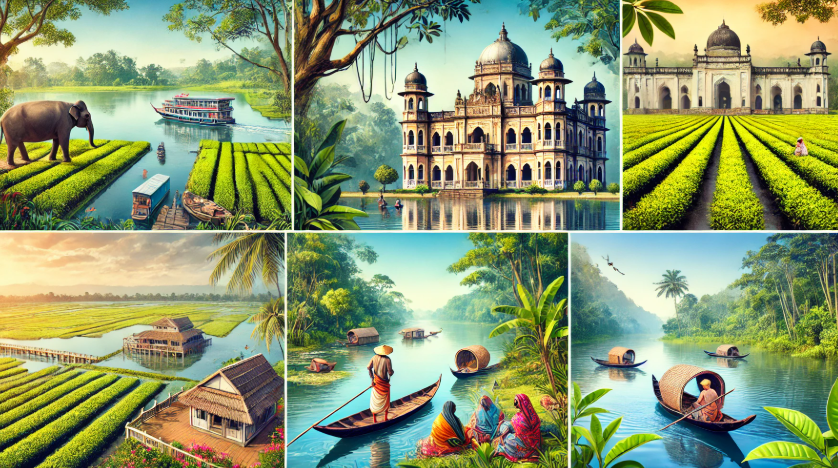Sunamganj, located in the northeastern part of Bangladesh, is a district renowned for its extraordinary natural beauty, vast wetlands, and rich cultural heritage. Often referred to as the “Land of Haors,” it is a haven for nature lovers, bird watchers, and spiritual seekers. The district is crisscrossed by countless rivers, dotted with serene haors, and enriched by a vibrant history that continues to inspire its people and visitors.
Geography and Natural Landscape
Sunamganj is part of the Sylhet Division and shares its northern border with the Indian state of Meghalaya. The district’s geography is dominated by its unique haor system, a large floodplain ecosystem that transforms into vast inland seas during the monsoon. This natural phenomenon, coupled with the surrounding hills and rivers, creates a breathtaking landscape that attracts tourists from around the globe.
Tanguar Haor: A Jewel of Biodiversity
Designated as a Ramsar Site of international importance, Tanguar Haor is the crown jewel of Sunamganj’s natural treasures. This 10,000-hectare wetland is a sanctuary for over 200 species of birds, including migratory species like pintails and storks. Its pristine waters and lush surroundings provide a critical habitat for fish, amphibians, and mammals. Visitors can explore Tanguar Haor on small boats, basking in its tranquil beauty and observing its rich biodiversity.
Jadukata River

The Jadukata River, flowing from the Meghalaya hills, is famous for its crystal-clear waters and sandy banks. It serves as a lifeline for the local communities, supporting fishing and agriculture. The river is also a favorite spot for tourists seeking serenity and scenic views.
Shimultola: A Vibrant Floral Haven

In the spring, Shimultola near the border areas becomes a vibrant display of blooming silk cotton trees (shimul), painting the landscape red and attracting photographers and nature enthusiasts.
Barikka Tila and Meghalaya Hills
Barikka Tila offers panoramic views of the haors and rolling hills of Meghalaya. The hills surrounding Sunamganj form a dramatic backdrop, enhancing the district’s scenic charm.
History and Culture
Sunamganj has a rich history shaped by its connection to the Sylhet region and its proximity to India. The district is particularly known for its association with mystic poets and Sufi saints who have left an indelible mark on its cultural identity.
Hason Raja: The Mystic Bard

Hason Raja, the legendary poet and philosopher, was born in Sunamganj. His soulful songs, steeped in themes of spirituality and humanism, continue to inspire generations. The Hason Raja Museum in Sunamganj town preserves his legacy with artifacts, manuscripts, and memorabilia.
Sufi Shrines and Spiritual Significance
The district is dotted with Sufi shrines, such as the Dargah of Hazrat Shah Kamal and Hazrat Shah Arifin. These shrines are not only spiritual centers but also historical landmarks that reflect Sunamganj’s cultural depth.
Economic Significance
Sunamganj’s economy thrives on fishing, agriculture, quarrying, and small-scale industries.
Fishing and Aquaculture
The haors of Sunamganj are teeming with fish, making fishing a major occupation for locals. The district is a significant contributor to the country’s fish production, with popular varieties like hilsa, rohu, and catfish.
Agriculture
Sunamganj’s fertile lands support the cultivation of boro rice, a staple in Bangladesh. During the dry season, the haor basins turn into vast golden rice fields, providing livelihoods to thousands of farmers.
Limestone and Sand Quarrying
The district is rich in natural resources like limestone and sand, which are extracted from the Jadukata and Surma rivers. These materials are vital for the construction industry in Bangladesh.
Sunamganj Administrative Divisions
Sunamganj is divided into 11 upazilas (sub-districts), each contributing to its diverse cultural and natural wealth:
- Sunamganj Sadar: The administrative and cultural hub, home to the Hason Raja Museum and bustling marketplaces.
- Tahirpur: Known for Tanguar Haor, Jadukata River, and limestone quarries.
- Chhatak: A major industrial zone, housing cement factories and other industries.
- Dharmapasha: Features sprawling haor landscapes and a vibrant agricultural community.
- Jamalganj: A tranquil area surrounded by haors and wetlands.
- Dowarabazar: A picturesque upazila with a mix of hills, forests, and rural beauty.
- Jagannathpur: Famous for its serene villages and vibrant local culture.
- Bishwamvarpur: Offers access to parts of Tanguar Haor and natural attractions.
- Shalla: Known for its lush green landscapes and community-centric lifestyle.
- South Sunamganj: Rich in wetlands and traditional farming practices.
- Derai: Hosts traditional fairs and festivals that reflect the district’s cultural diversity.
Festivals and Traditions
Sunamganj’s cultural calendar is filled with vibrant festivals. The Baisakh Fair, celebrating the Bengali New Year, showcases traditional crafts, music, and cuisine. Folk music, particularly the songs of Hason Raja and other mystic poets, plays a significant role in the district’s identity.
Tourism in Sunamganj
Tourism in Sunamganj is growing rapidly, driven by its natural and cultural attractions. Eco-tourism initiatives have been introduced to preserve the haors and promote sustainable tourism.
Attractions to Explore
- Tanguar Haor: Perfect for bird-watching and boat rides.
- Lauachhara Eco Park: A lesser-known spot for nature walks and biodiversity.
- Jadukata River: Ideal for picnics and scenic photography.
- Hason Raja Museum: A glimpse into the life of a legendary poet.
How to Get There
Sunamganj is approximately 250 kilometers from Dhaka. The district can be reached by road via Sylhet, with regular bus services operating between the cities. Boats are also a popular mode of transport for exploring the haors and rivers.
Why Visit Sunamganj?
Sunamganj is a destination that offers an unparalleled combination of natural beauty, cultural richness, and historical depth. Whether you’re exploring the wetlands, delving into the works of Hason Raja, or soaking in the serenity of the rivers, Sunamganj promises an unforgettable experience for every traveler.



